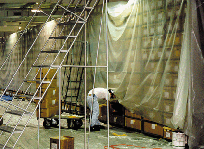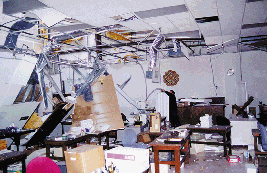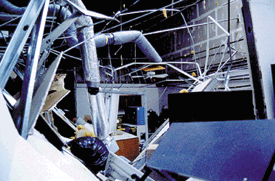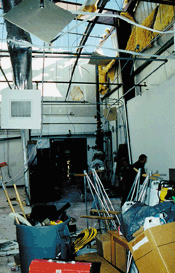TIC-TAC-Tornado
Willie Jones
This article appeared in Disaster Recovery Journal,
Volume 12, Issue 2, Spring 1999
 This game of hit and miss took place in
Columbia, Missouri around 2:15 a.m. on November 10, 1998. As I lay
sleeping, I was awakened by the weather alarms nearby. My family and
I heard very strong winds and then the power went out all over the
area. Living in a mobile home, I quickly got my family up and out to
the car. Our plan was to go to the elementary school next door or the
University of Missouri Police Department or to our church, to which my
wife has the keys.
This game of hit and miss took place in
Columbia, Missouri around 2:15 a.m. on November 10, 1998. As I lay
sleeping, I was awakened by the weather alarms nearby. My family and
I heard very strong winds and then the power went out all over the
area. Living in a mobile home, I quickly got my family up and out to
the car. Our plan was to go to the elementary school next door or the
University of Missouri Police Department or to our church, to which my
wife has the keys.
We were intercepted by our neighbors who said they had just heard
on their scanner, that the storm had passed our area and was heading
northwest, out of Boone County. The wind had slowed down and the
alarms had stopped. After going back indoors for about five or six
minutes, we began to feel the wind picking up very quickly as it
went over the top of the mobile home park. Then we heard a sound
such as a train, and a lot of rumbling noise.
 A short time later one of my
co-workers, a member of our Disaster Recovery Team (DRT) called to
inform me of damage to our Records Management facility at the
University of Missouri. As he continued to make the calls from the
DRT phone tree, I headed over to our facility. There were police and
other emergency personnel waiting to stop me from entering the
location. Around 4:30 AM, after talking to two or three different
officials and identifying myself as the DRT Coordinator, I was
allowed to enter the building.
A short time later one of my
co-workers, a member of our Disaster Recovery Team (DRT) called to
inform me of damage to our Records Management facility at the
University of Missouri. As he continued to make the calls from the
DRT phone tree, I headed over to our facility. There were police and
other emergency personnel waiting to stop me from entering the
location. Around 4:30 AM, after talking to two or three different
officials and identifying myself as the DRT Coordinator, I was
allowed to enter the building.
I could not believe the amount of damage I was seeing, just one
quarter of a mile from my mobile home park. There were roofs off
buildings, trees twisted off at the middle, loading dock doors
completely gone. At daylight I was able to see much more damage.
Steel beams were bent in the walls and roof; inside walls were down
and fire walls displaced. The Microfilm Operations department was
ripped apart. Large sections of our roof in the Records Center were
missing. Windows were blown out of the building as well as out of
the delivery vehicles. There were many birds blown onto the drive
from the trees and one was found inside one of the delivery vans.
 A large part of my responsibility
was to photograph all of the damage, both inside and out, from
different viewpoints. We continued to document the recovery
activities as the cleanup took place.
A large part of my responsibility
was to photograph all of the damage, both inside and out, from
different viewpoints. We continued to document the recovery
activities as the cleanup took place.
Fortunately, as part of our Disaster Plan, we had stocked
recovery supplies such as: large and medium tarps, flashlights and
batteries, battery power radio, mops and other smaller items to aid
us in the pack-out of wet documents.
Upper management performed like the professionals that they are.
They made all of the arrangements for activation of insurance and
freeze drying of documents as well as calls to contractors.
The pattern or course taken by the tornado was as if it were
playing a game of tic-tac-toe. Several homes were badly damaged to
the point that they unoccupied. But, the many mobile home parks and
other buildings, even along our block, were untouched. I had raked
up the leaves in my yard the evening before and they were completely
undisturbed.
 Our company was very blessed as none
of our records were blown from the building or otherwise lost.
Because of the hour the storm hit, we had no injuries to any of our
staff. By early morning we had contractors already on site to
evaluate the damage and make emergency repairs. Because of the
support we received from top management, we were able to start the
cleanup very quickly. The clearing of debris, such as downed walls,
ceiling tiles, insulation and electrical conduits by contracted
staff, allowed the DRT to focus on the recovery and protection of
records and computer systems.
Our company was very blessed as none
of our records were blown from the building or otherwise lost.
Because of the hour the storm hit, we had no injuries to any of our
staff. By early morning we had contractors already on site to
evaluate the damage and make emergency repairs. Because of the
support we received from top management, we were able to start the
cleanup very quickly. The clearing of debris, such as downed walls,
ceiling tiles, insulation and electrical conduits by contracted
staff, allowed the DRT to focus on the recovery and protection of
records and computer systems.
By day two, the DRT had pulled and repacked 226 boxes for freeze
and air drying later. We also spent a considerable amount of time
carrying valuable equipment to safety and covering it for the
microfilm lab. Our microfilm operations department and another
department from our facility were temporarily relocated down the
block to another University building. Both were operational within
eight days. By day three, the Records Center provided limited
services to customers. There are two other departments also housed
in our facility which were hit as hard or worse.
Disaster can and will happen at some point, whether on the job or
in our homes. The best defense when they occur is to have a plan
that is tested and other resources to meet the needs of our
organization and the safety of its staff.
Your plan must be tailored to your organization and every person
and department located within that facility.
The greatest lesson we'll ever learn when it comes to continuity
planning:
Any plan is better than not having a plan.
Willie M. Jones is a part of the Records Analyst Records
Management at the University of Missouri System. He can be contacted
by email at Jonesw@umsystem.edu
 This game of hit and miss took place in
Columbia, Missouri around 2:15 a.m. on November 10, 1998. As I lay
sleeping, I was awakened by the weather alarms nearby. My family and
I heard very strong winds and then the power went out all over the
area. Living in a mobile home, I quickly got my family up and out to
the car. Our plan was to go to the elementary school next door or the
University of Missouri Police Department or to our church, to which my
wife has the keys.
This game of hit and miss took place in
Columbia, Missouri around 2:15 a.m. on November 10, 1998. As I lay
sleeping, I was awakened by the weather alarms nearby. My family and
I heard very strong winds and then the power went out all over the
area. Living in a mobile home, I quickly got my family up and out to
the car. Our plan was to go to the elementary school next door or the
University of Missouri Police Department or to our church, to which my
wife has the keys.
 A short time later one of my
co-workers, a member of our Disaster Recovery Team (DRT) called to
inform me of damage to our Records Management facility at the
University of Missouri. As he continued to make the calls from the
DRT phone tree, I headed over to our facility. There were police and
other emergency personnel waiting to stop me from entering the
location. Around 4:30 AM, after talking to two or three different
officials and identifying myself as the DRT Coordinator, I was
allowed to enter the building.
A short time later one of my
co-workers, a member of our Disaster Recovery Team (DRT) called to
inform me of damage to our Records Management facility at the
University of Missouri. As he continued to make the calls from the
DRT phone tree, I headed over to our facility. There were police and
other emergency personnel waiting to stop me from entering the
location. Around 4:30 AM, after talking to two or three different
officials and identifying myself as the DRT Coordinator, I was
allowed to enter the building.
 A large part of my responsibility
was to photograph all of the damage, both inside and out, from
different viewpoints. We continued to document the recovery
activities as the cleanup took place.
A large part of my responsibility
was to photograph all of the damage, both inside and out, from
different viewpoints. We continued to document the recovery
activities as the cleanup took place.
 Our company was very blessed as none
of our records were blown from the building or otherwise lost.
Because of the hour the storm hit, we had no injuries to any of our
staff. By early morning we had contractors already on site to
evaluate the damage and make emergency repairs. Because of the
support we received from top management, we were able to start the
cleanup very quickly. The clearing of debris, such as downed walls,
ceiling tiles, insulation and electrical conduits by contracted
staff, allowed the DRT to focus on the recovery and protection of
records and computer systems.
Our company was very blessed as none
of our records were blown from the building or otherwise lost.
Because of the hour the storm hit, we had no injuries to any of our
staff. By early morning we had contractors already on site to
evaluate the damage and make emergency repairs. Because of the
support we received from top management, we were able to start the
cleanup very quickly. The clearing of debris, such as downed walls,
ceiling tiles, insulation and electrical conduits by contracted
staff, allowed the DRT to focus on the recovery and protection of
records and computer systems.